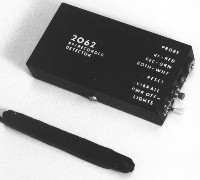
The 2062 is a sensitive, broadband (1 to 2,000+ MHz) radio frequency (RF) indicator coupled with a tape recorder bias oscillator detector. Sensitivity of both detection modes has been placed at a level consistent with normal background radiation. A very low frequency (VLF) bias oscillator signal radiates from many, but not all, types of tape recorders when in the RECORD mode. Detected signals are displayed either by a dual color (RED and GREEN) light emitting diode (LED) or an internal silent vibrator. The mode of detection is determined by the PWR (power) switch. The 2062 is powered by a single 9 volt battery (Alkaline preferred) which provides approximately 100 hours of ON time.
INSTALLATION/OPERATION: Insert the VLF probe/antenna into the PROBE jack. Place the main detector unit in the left side pants pocket so that the RESET button can be easily reached by the left hand. Run the probe wire around the back and down the right sleeve so the probe rests on the lower edge of the right arm midway between the wrist and elbow. Use the expansion band supplied to fasten the probe in place. This position will assure that the probe passes as close as possible to any suspect transmitter or recorder while shaking hands or gesticulating. Turn the PWR switch to the VIBRATE position: the vibrator should indicate briefly. Press the RESET button. The unit then automatically adjusts its sensitivity to ambient signal conditions. The 2062 is broadband and will indicate the presence of all RF transmitters operating in the range of 1 to 2,000+ MHz including aircraft, CB, taxi, etc. transmitters. The latter can be readily identified by the fact that their carriers (transmitted signal) will be keyed on and off fairly quickly. A surveillance device or recorder, on the other hand, will emit a constant signal thereby keeping the light or vibrator indicating continuously. When using the 2062 bear in mind that it indicates when the received signal increases. If, when an area is approached, the unit indicates, back away from that area and press the RESET button. If the signal appears to be random interference, again press the RESET button to adjust the 2062 for that signal level then re-approach the desired area.
There are some conditions under which the recorder (bias oscillator) detector may give incorrect indications. Since this portion of the 2062 detects signals from 10 to 250 Kilohertz (KHz) it will readily indicate the horizontal sweep frequency (15 KHz) of any nearby TV set. Noisy (RF) fluorescent lights and VLF transmitters can also be a problem. Use the unit at least 100 feet away from any operating TV set and as far away as possible from fluorescent lights: If a high RF or noise environment is encountered, the 2062 may indicate continuously. To reset the unit for these conditions, press the RESET button for two or three seconds. The 2062 may indicate briefly after the RESET button is released but will return to normal operation.
The 2062 may also be used to sweep a room. To operate as a hand held detector, hold the main detector unit in one bar='' and the probe in the other. Pass the antenna (probe wire) as close as possible to the object or area being swept while observing the LED or vibrator. With the PWR switch in either the LIGHTS or VIBRATE position the LED will glow RED in the presence of RF energy and green (GRN) in the presence of a VLF bias oscillator signal (recorder). If both an RF and bias oscillator signal are present the two colors of the LED will combine to create white (WHT) light.
The 2062 is powered by a single 9 volt battery (Alkaline preferred) which should be replaced, at the latest, when the unit starts to indicate slowly when turned ON. To replace the battery, loosen the two (2) screws on the sides of the unit one or two turns. With the lettered side facing down, carefully remove the back cover, then the old battery: Snap in a fresh battery and position it in the case so the battery leads will not interfere with the vibrator or be pinched by the back cover when it is re installed. Replace the cover and tighten the screws (don't over-tighten).
As with any piece of sophisticated electronic equipment, remove the battery if prolonged periods of storage are anticipated.
GLOSSARY February 2000
Hz Megahertz (1 MHz = 1,000 KHz = 1,000,000 Hz)
RF Radio Frequency
VLF Very Low Frequency
LED Light Emitting Diode
CB Citizen Band
KHz Kilohertz (1 KHz = 1,000 Hz)
Hz Hertz - Basic unit of frequency measurement i.e. one
complete cycle per second.